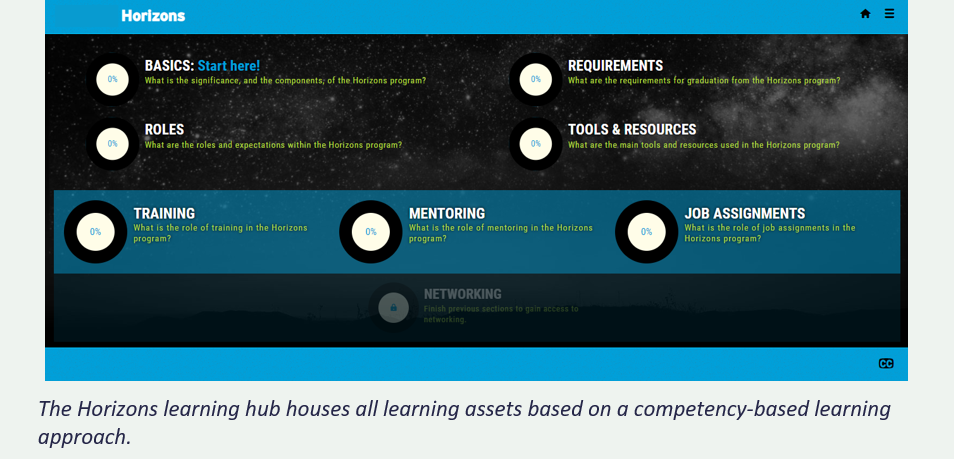Competency-Based Learning Examples For Your Corporation's Training Needs
The classic approach to organizational Learning and Development is often reactionary. Someone gets hurt—we need safety training. A new law was passed—we need to create and distribute a quick reference card. A new software rollout—we need new eLearning training modules. There is nothing inherently wrong with such an approach, but if pure reactive learning is the basis for all learning in the organization, over time employees will have difficulty distinguishing the old from the new and the out of date from the most up to date.

Competency-based learning moves away from that model and instead is based on a carefully thought out analysis of the competencies required from employees to achieve organizational success. Creating a competency-based program requires both planning and collaboration.
Careful planning is necessary because competency-based learning is not a function of HR alone but should involve the strategic functions of an entire organization or team. It follows that collaboration is essential, as all parties must be clear about the company’s vision, plans, and potential business scenarios in order to develop a viable competency-based learning program.
The first step in the process, competency mapping, is the basis for all of the competency-based activities that will be linked to the overall competency-based program. Though not an exhaustive list, these might include:
- Recruitment
- Performance appraisal
- Training
- Development
- Remuneration
If your organization has a desire to explore competency-based learning, and you’ve been tasked with developing learning assets within that framework, you can see that the exercise will require some effort.
But never fear, Obsidian Learning is here to help. Over the years we’ve successfully advised our clients on how to integrate competency-based learning into their Learning and Development programs, scaling to the specific needs of each organization. In the following examples, you’ll see how competency-based learning can be adapted to fit a variety of learning needs, and the strategies and deliverables that we employ to meet established learning objectives.
1. Comprehensive Competency-Based Learning Program
It is ideal for small- to medium-sized organizations, start-ups, organizational restructuring/reorganizations.
Rationale
Competency-based learning is intimately intertwined with competency mapping, which in turn is only effective when aligned with the business goals and specific objectives of individual departments or teams. The "reset" that often follows major reorganization or change to organizational structure such as downsizing or mergers can be the ideal moment to integrate a competency-based learning approach to existing or planned learning deliverables.
Comprehensive competency-based learning programs require an organizational commitment and resources beyond those required for the reactive learning approach. This initial cost outlay will eventually find its way back to the organization in the form of increased ROI; competency-based learning content is inherently more stable over the long term.
- Advantages
A clean slate to do things right from the beginning. No need for change management or communication initiatives. Little to no resistance from employees. - Disadvantages
Relatively costly (though ROI is huge). May take time to fully execute (though strategic learning design with prioritization can partially mitigate the need for developing completely new learning assets.)
Case Study
In 2011 Obsidian Learning was approached by a small oil-and-gas service start-up. After initial talks, they were convinced that competency-based learning was the way to go. They granted our learning strategist access to top management and, equally importantly, to their VP of operations and senior operations management. As our combined teams worked to draft a competency map, the involvement of management was a critical factor both in terms of speed and in nailing down the substantive competencies.
A competency map for the entire organization was crafted within roughly 30 hours. The organization’s structure (operations were conducted in relatively small teams of 3-4 individuals with a more experienced team lead, two specialized technicians and potentially a newbie who would be trained on the job with the fully functioning team) allowed for scalability of not only the learning approach but also supported organic growth of the company.
An in-depth design of the key learning programs and associated assets and deliverables was ready for review after about an additional 10 hours of work.
Development and implementation of the learning deliverables was the lengthiest part of the process, being fully executed 9 months after the initial interviews with top management. Obsidian created a set of beautiful, highly visual, multi-functional deliverables that are still being used to this day.
2. Isolated Competency-Based Learning Program
It is ideal for new departments/teams, departments/teams undergoing reorganization/restructuring.
Rationale
A substantial number of our past, current, and potential clients have not established their Learning and Development initiatives around competencies but have existing libraries of learning assets. These include eLearning modules, learning videos, workshops, and Instructor-Led training that might or might not align with desired competencies. Attempting to shift the entire learning structure of an organization toward a competency-based program might be cost-prohibitive, time-consuming, or a combination of both. The opportunity usually presents itself during a period of change. This could be something along the lines of the creation of a new department or a significant reorganization of an existing structure such as a steering team or any team with a reoccurring objective. Managerial motivation to "do it right" often stems from this type of novelty.
- Advantages
The initiative is confined to a fragment of the organization, reducing the associated fear that accompanies most change. It can be accomplished within a reasonable budget. Great potential to reuse, recycle, or upcycle existing learning assets. - Disadvantages
Resistance from departments that oversee the new organizational structure. An instinct for consistency in maintaining established learning philosophy from a department or an individual overseeing the new team (both reservations can be successfully addressed by a clear understanding of the benefits of competency-based learning).
Case Study
A Fortune 5 multinational company—one of our loyal clients—decided to create a new onboarding initiative focused on its top recruited talent. The need for accelerated growth of these highly talented engineers and managers made all the sense in the world. Since the target audience was based on the ideal employee, creating the competency map which helped pinpoint the most appropriate learning assets was no great challenge.
The design and development of the competency-based onboarding program took less than 2 months. We were able to leverage roughly 60% of the content from existing materials created for the general onboarding process and created new assets such as videos, animation, and interactive online games to compensate for the unique nature of the target audience. After a successful rollout, Obsidian Learning was also tasked with creating an online application housing this program, making it 100% digital (prior to this change, many onboarding activities for top talent took place during costly, in-person workshops).
This program is also currently still in use.

3. Competency-Based Learning Audit And Learning Asset Review
It is ideal for organizations that sense that the learning department could be achieving better results but are understandably wary of major, dramatic change.
Rationale
Though many organizations have only the best intentions for their employees/learners in mind, the reality of a day-to-day business environment can impact how learning is conducted. Though the HR team and management might really be on board to overhaul the learning program, they might be constrained by having to work within the existing environment and delivering results here and now.
Obsidian loves working with professionals who are pulling off this balancing act. A competency-based learning audit is a relatively short and simple exercise that usually involves the head of a department or team and an HR representative with conceptual knowledge of the employees who are part of this team.
We review and ultimately cross-reference:
- The objectives and expectations of the team in question
- The job descriptions and composition of the team
- Existing learning assets and deliverables
Based on our findings we propose the ideal competency-based learning program and identify the learning assets that:
- Can be used in their current state
- Could be improved (with a focus on small, cosmetic changes)
- Should be redeveloped or will require a major overhaul
- Should be created from scratch
We also create an action plan with proposed priorities and timelines. This type of collaboration with clients who choose this approach starts slow but tends to remain steady and often develops into a comfortable, long-term partnership.
- Advantages
This carefully crafted, and cautious approach had become very popular with many of our clients. The initial deliverable is an audit that doesn’t break the bank or the clock. Because it focuses on careful analysis of the status quo based upon which we develop our recommendations, it can be executed over a longer period. It can also be paused or even stopped at the will of the client. If the client is so inclined, they can create or update the recommended deliverables in-house or even hire a different vendor. - Disadvantages
In our experience, clients sometimes focus only on the most critical recommendations as opposed to taking into account the wider scope of our analysis. Ultimately this can affect the effectiveness of the learning, as over the long term a holistic competency-based learning program will provide a stronger foundation for the work of a department, team, or entire organization.
As these examples demonstrate, competency-based learning can be adapted to fit a variety of organizations and a variety of learning needs. At Obsidian Learning we recognize the value in scaling competency-based learning to fit the needs of our clients and working with them to find the best competency-based learning solutions for their organizations. Download the eBook Competency-Based Learning: Increase Employee Skills Development Through Competency-Based Learning to discover more about this highly-strategic approach to employee skills development.









